Mobile:+86-311-808-126-83
Email:info@ydcastings.com
A Guide to Casting Brass Using Sand Molds and Techniques
How to Cast Brass in Sand A Step-by-Step Guide
Casting brass in sand is an age-old technique that combines artistry with engineering. Brass, an alloy composed mainly of copper and zinc, is prized for its excellent mechanical properties, corrosion resistance, and aesthetic appeal. Sand casting is a versatile and affordable method of producing brass components, suitable for both small-scale projects and large industrial applications. In this article, we will guide you through the essential steps to successfully cast brass in sand.
Step 1 Gather Your Materials
Before beginning the casting process, you’ll need to gather the following materials and equipment
1. Melting Furnace A propane or electric furnace capable of reaching the melting point of brass (about 900-940°C or 1650-1720°F). 2. Sand Molding Material Use a mixture of fine sand and a binder (like clay) to create a mold. The mixture should be damp but not too wet to ensure it holds its shape. 3. Pattern A model of the object you wish to cast, made from wood, metal, or plastic. The pattern is what will create the cavity in the sand mold. 4. Core If your design requires hollow features, you might need a core made from sand or metal. 5. Pouring Equipment A ladle to pour the molten brass into the mold. 6. Protective Gear Safety glasses, gloves, and a face shield to protect against heat and splashes.
Step 2 Create the Sand Mold
To create the sand mold
1. Prepare the Pattern Clean the pattern to remove any dirt or grease. Apply a release agent to prevent the sand from sticking. 2. Build the Mold Place the pattern on a flat surface and pack sand around it, ensuring it is compacted tightly. The sand should be packed firmly around the pattern to capture its details.
3. Remove the Pattern Carefully pull the pattern out of the sand, leaving a cavity in its shape. If your casting has multiple parts, repeat this process for each section.
4. Assemble the Mold If your design consists of multiple pieces, ensure they fit together perfectly. You may use pins or other alignment tools to help in this process.
5. Create Pouring Channels Establish gates and risers in the mold, which will allow molten brass to flow in and any gases to escape.
Step 3 Melt the Brass
1. Prepare the Furnace Ensure your furnace is clean and functioning properly. Preheat it to the required temperature for melting brass.
how to cast brass in sand

2. Load the Brass Place brass scrap or pre-formed brass ingots into the furnace. Monitor the temperature closely to ensure it reaches the necessary heat for complete melting.
3. Pour the Molten Brass Once the brass has melted, use a ladle to carefully pour the molten metal into the sandbox mold. Be sure to pour steadily and avoid splashing, as molten brass can cause severe burns.
Step 4 Cool and Remove the Mold
1. Allow to Cool Let the brass casting cool in the mold for several hours. Cooling times can vary based on the size of the casting.
2. Break the Mold Once cooled, carefully break away the sand to reveal your brass casting. Use a soft hammer or your hands to gently remove the sand without damaging the casting.
3. Clean the Casting Remove any remaining sand using water, or a brush. For more intricate clean-up, sandblasting or tumbling can be effective.
Step 5 Finishing Touches
1. Inspect Your Work Check the casting for any defects, such as porosity or uneven surfaces.
2. Machining If necessary, perform machining or grinding to achieve the desired dimensions and finish.
3. Polish Brass can be polished to enhance its natural luster. Use appropriate polishing compounds and tools to achieve a brilliant shine.
Conclusion
Casting brass in sand can be a rewarding process, turning raw materials into beautiful and functional objects. With practice and attention to detail, anyone can master this technique. Whether you’re creating art pieces, components for machinery, or intricate jewelry, the art of sand casting offers endless possibilities. Remember, safety is paramount, so always follow proper protocols to safeguard yourself during this fascinating journey into metalworking. Happy casting!
-
Impeller Technology That Powers Precision in Pump SystemsNewsMay.22,2025
-
Valve Durability Begins with Quality Cast Iron ComponentsNewsMay.22,2025
-
Performance Cooling with Advanced Automobile Water Pump SolutionsNewsMay.22,2025
-
How Motor Housing and Oil Pans Shape Engine PerformanceNewsMay.22,2025
-
How Metal Castings Drive Modern Manufacturing EfficiencyNewsMay.22,2025
-
Exploring the Engineering Behind Valve Body CastingsNewsMay.22,2025











